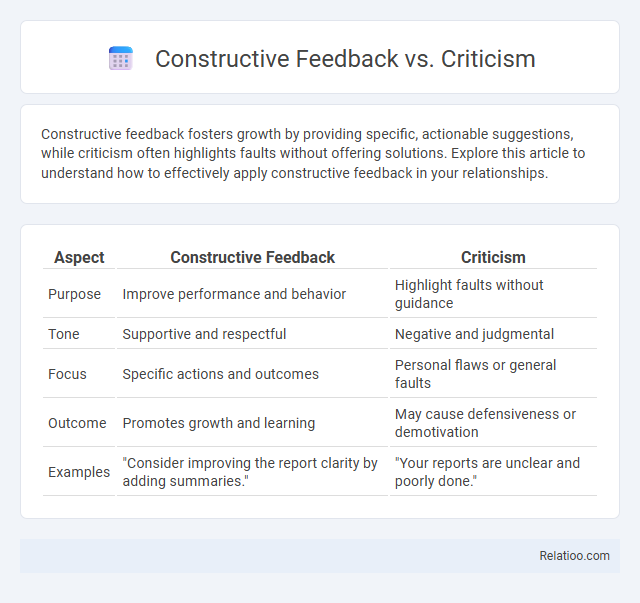Constructive feedback fosters growth by providing specific, actionable suggestions, while criticism often highlights faults without offering solutions. Explore this article to understand how to effectively apply constructive feedback in your relationships.
Table of Comparison
| Aspect | Constructive Feedback | Criticism |
|---|---|---|
| Purpose | Improve performance and behavior | Highlight faults without guidance |
| Tone | Supportive and respectful | Negative and judgmental |
| Focus | Specific actions and outcomes | Personal flaws or general faults |
| Outcome | Promotes growth and learning | May cause defensiveness or demotivation |
| Examples | "Consider improving the report clarity by adding summaries." | "Your reports are unclear and poorly done." |
Understanding Constructive Feedback and Criticism
Constructive feedback focuses on specific behaviors and actionable suggestions aimed at improvement, while criticism often highlights faults without offering solutions, which can lead to defensiveness. Understanding the intent behind feedback helps you differentiate between helpful guidance and negative remarks, fostering professional growth. Recognizing this distinction enables you to respond productively, turning potentially discouraging moments into opportunities for development.
Key Differences Between Feedback and Criticism
Constructive feedback provides specific, actionable suggestions aimed at improvement, focusing on behaviors and outcomes rather than personal attributes, while criticism often highlights faults or shortcomings without offering solutions, potentially lowering motivation. Feedback encourages growth by addressing what can be changed, whereas criticism may lead to defensiveness due to its negative tone. Understanding these differences allows you to give or receive input that fosters development rather than frustration.
The Impact of Feedback vs Criticism on Growth
Constructive feedback fosters growth by providing actionable insights that help you identify strengths and areas for improvement, enhancing skills and confidence. Criticism, especially when vague or negative, can hinder progress by focusing on faults without offering solutions, often leading to diminished motivation. Frustration arises when feedback lacks clarity or purpose, obstructing development and causing emotional barriers to learning and growth.
Emotional Responses: Navigating Feedback and Criticism
Constructive feedback fosters positive emotional responses by offering specific, actionable insights that promote growth and motivation. Criticism often triggers defensive reactions and decreased self-esteem when perceived as personal attacks rather than helpful guidance. Frustration arises from repeated negative feedback without solution-oriented suggestions, leading to disengagement and diminished productivity.
Elements of Effective Constructive Feedback
Effective constructive feedback includes clear, specific observations that focus on behaviors rather than personal traits, enabling the recipient to understand and improve performance. It emphasizes actionable suggestions, maintains a supportive tone, and balances positive reinforcement with areas for growth, fostering a productive learning environment. Your ability to deliver such feedback enhances communication, reduces frustration, and differentiates it from mere criticism, which often lacks these key elements.
Identifying Harmful Criticism in Communication
Identifying harmful criticism in communication involves recognizing comments that target personal attributes rather than behavior or performance, often leading to defensiveness and diminished morale. Constructive feedback is specific, actionable, and delivered with the intent to improve, whereas harmful criticism tends to be vague, judgmental, and emotionally charged, contributing to frustration. Differentiating these forms is essential for fostering healthy dialogue and maintaining positive interpersonal relationships.
Transforming Criticism into Constructive Input
Transforming criticism into constructive input involves reframing negative feedback into specific, actionable suggestions that promote growth and improvement. Emphasizing clear communication and empathy helps reduce frustration by focusing on solutions rather than blame. This approach enhances team dynamics and supports continuous development by turning potential conflicts into opportunities for learning.
Techniques for Delivering Constructive Feedback
Effective techniques for delivering constructive feedback include focusing on specific behaviors rather than personal traits, using clear and objective language to avoid misunderstandings, and balancing positive comments with areas for improvement to maintain motivation. Employing the "sandwich method," where praise precedes and follows the feedback, helps recipients remain open and receptive. Active listening and encouraging two-way communication foster a supportive environment, ensuring feedback leads to meaningful growth and development.
How to Receive and Respond to Feedback or Criticism
Receiving constructive feedback involves actively listening, asking clarifying questions, and separating the message from your emotions to use it for personal or professional growth. Differentiating criticism from frustration helps you respond calmly and objectively, avoiding defensive reactions and seeking to understand the underlying issues. Your ability to respond thoughtfully to feedback or criticism strengthens communication, builds trust, and fosters ongoing improvement in any relationship or work environment.
Building a Positive Culture of Feedback
Constructive feedback fosters a positive culture by focusing on specific behaviors and actionable improvements that help individuals grow. Unlike criticism, which often highlights faults without solutions, constructive feedback encourages learning and development, reducing frustration and promoting engagement. Your approach to communication shapes whether feedback is perceived as supportive guidance or negative judgment, ultimately influencing team morale and performance.

Infographic: Constructive Feedback vs Criticism
 relatioo.com
relatioo.com